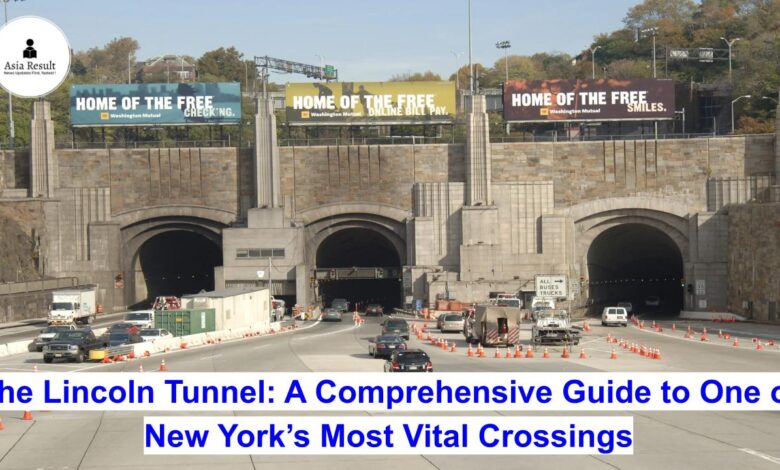The Lincoln Tunnel: A Comprehensive Guide to One of New York’s Most Vital Crossings

The Lincoln Tunnel is more than just a passageway between New York and New Jersey; it’s an engineering marvel and a crucial artery in the bustling transportation network of the metropolitan area. With its iconic underwater tubes, the Lincoln Tunnel facilitates the daily commute of thousands of drivers, playing a vital role in the region’s economy and connectivity.
In this article, we’ll delve into the history, design, and daily operation of the Lincoln Tunnel, address common issues like Lincoln Tunnel traffic, closures, and how to navigate them, and provide answers to frequently asked questions.
The History of the Lincoln Tunnel
The Lincoln Tunnel, named after President Abraham Lincoln, was conceived in the early 20th century as a solution to the growing traffic congestion between New York and New Jersey. Construction of the first tube began in 1934, during the Great Depression, under the direction of the Port Authority of New York and New Jersey. The first tube was completed and opened to traffic on December 22, 1937.
The tunnel was initially planned as a single tube, but the high volume of traffic soon necessitated the construction of additional tubes. The second tube opened in 1945, and the third was completed in 1957. Today, the Lincoln Tunnel consists of three separate tubes, each containing two lanes, facilitating a steady flow of vehicles between Manhattan and Weehawken, New Jersey.
The Engineering Behind the Lincoln Tunnel
The Lincoln Tunnel is a feat of civil engineering, designed to withstand the pressures of being submerged beneath the Hudson River. The tunnel is constructed with thick concrete walls and a series of ventilation systems to manage the exhaust from thousands of vehicles that pass through daily.
Each tube measures approximately 1.5 miles in length and dips to a depth of 97 feet below the river’s surface at its lowest point. The construction involved sinking steel caissons into the riverbed, which were then connected to form the tunnel structure. The tubes were lined with concrete and fitted with a state-of-the-art ventilation system that remains operational today.
The Lincoln Tunnel’s design also incorporates advanced safety features, including emergency exits, fire suppression systems, and round-the-clock monitoring by the Port Authority’s operations center.
Navigating Lincoln Tunnel Traffic
One of the most common concerns for drivers is Lincoln Tunnel traffic. Due to its location and the sheer volume of vehicles, traffic congestion is a frequent issue, particularly during rush hours. Here are some tips to help you navigate Lincoln Tunnel traffic more effectively:
- Plan Your Trip: If possible, try to avoid peak hours. The heaviest traffic usually occurs between 7:00 AM and 10:00 AM and between 4:00 PM and 7:00 PM on weekdays. Weekends can also be busy, especially during special events or holiday weekends.
- Use Real-Time Traffic Apps: Tools like Google Maps, Waze, and the Port Authority’s own traffic updates can provide real-time information on traffic conditions. These apps can suggest alternative routes or help you decide when it’s best to use the Lincoln Tunnel.
- Consider Public Transportation: Depending on your destination, taking public transit might be a better option. SEPTA (Southeastern Pennsylvania Transportation Authority) offers several routes that connect to New York City, and buses and trains often bypass tunnel traffic, especially during peak hours.
- Use the HOV Lane: If you’re carpooling, you can take advantage of the High Occupancy Vehicle (HOV) lanes, which are usually less congested. This can save you a significant amount of time during your commute.
Lincoln Tunnel Closures and Maintenance
The Lincoln Tunnel requires regular maintenance to ensure the safety and efficiency of its operations. This can sometimes lead to partial or full closures, typically scheduled during off-peak hours to minimize disruption.
Common Reasons for Tunnel Closures:
- Routine Maintenance: The Port Authority conducts regular inspections and maintenance, which may include cleaning, electrical work, or structural repairs.
- Emergency Repairs: Occasionally, unforeseen issues such as water leaks or structural damage necessitate immediate repairs, leading to unexpected closures.
- Weather-Related Closures: Severe weather, such as heavy snowstorms or flooding, can result in temporary tunnel closures.

How to Stay Informed About Closures:
- Port Authority Alerts: The Port Authority provides real-time updates on tunnel closures through their website and social media channels.
- Traffic Apps: As mentioned earlier, apps like Waze and Google Maps can also notify you of closures and suggest alternate routes.
- Local News: Traffic updates are regularly broadcast on local news channels, particularly during rush hours.
Frequently Asked Questions About the Lincoln Tunnel
How deep is the Lincoln Tunnel?
The Lincoln Tunnel reaches a depth of approximately 97 feet below the Hudson River at its deepest point.
How long is the Lincoln Tunnel?
The Lincoln Tunnel is about 1.5 miles long, with each of the three tubes containing two lanes of traffic.
When was the Lincoln Tunnel built?
Construction of the Lincoln Tunnel began in 1934, and the first tube opened to traffic in 1937. The second tube was completed in 1945, and the third was finished in 1957.
How do I avoid traffic at the Lincoln Tunnel?
To avoid traffic, try to travel during off-peak hours, use real-time traffic apps, and consider alternative routes or public transportation.
Is the Lincoln Tunnel closed for maintenance often?
The Lincoln Tunnel undergoes regular maintenance, but closures are typically scheduled during late-night or early-morning hours to minimize disruption.
Can I bike or walk through the Lincoln Tunnel?
No, the Lincoln Tunnel is not accessible to pedestrians or cyclists. It is strictly for vehicular traffic.
What is the best time to travel through the Lincoln Tunnel?
The best time to travel through the Lincoln Tunnel is typically during off-peak hours, such as mid-morning or early afternoon on weekdays.
The Lincoln Tunnel’s Impact on the Region
The Lincoln Tunnel is not just a critical transportation link but also an economic lifeline for the New York-New Jersey metropolitan area. It facilitates the daily commute of thousands of workers, supports commerce by enabling the swift movement of goods, and serves as a vital connection for millions of travelers each year.
The tunnel’s role extends beyond transportation. It has become a symbol of the region’s resilience and adaptability, standing as a testament to the power of innovation and engineering. Whether you’re a daily commuter, a visitor, or a logistics professional, the Lincoln Tunnel is an integral part of your journey through one of the busiest metropolitan areas in the world.
Conclusion
The Lincoln Tunnel is more than just a conduit between New York and New Jersey—it’s a marvel of engineering, a vital piece of infrastructure, and a daily challenge for commuters dealing with traffic and closures. By understanding its history, how it operates, and how to navigate its challenges, you can better appreciate the significance of this remarkable tunnel.
Whether you’re interested in the Lincoln Tunnel traffic, concerned about closures, or just curious about its history, this guide provides the essential information you need. As one of the busiest tunnels in the world, the Lincoln Tunnel is an integral part of the fabric that connects the bustling urban centers on either side of the Hudson River.




